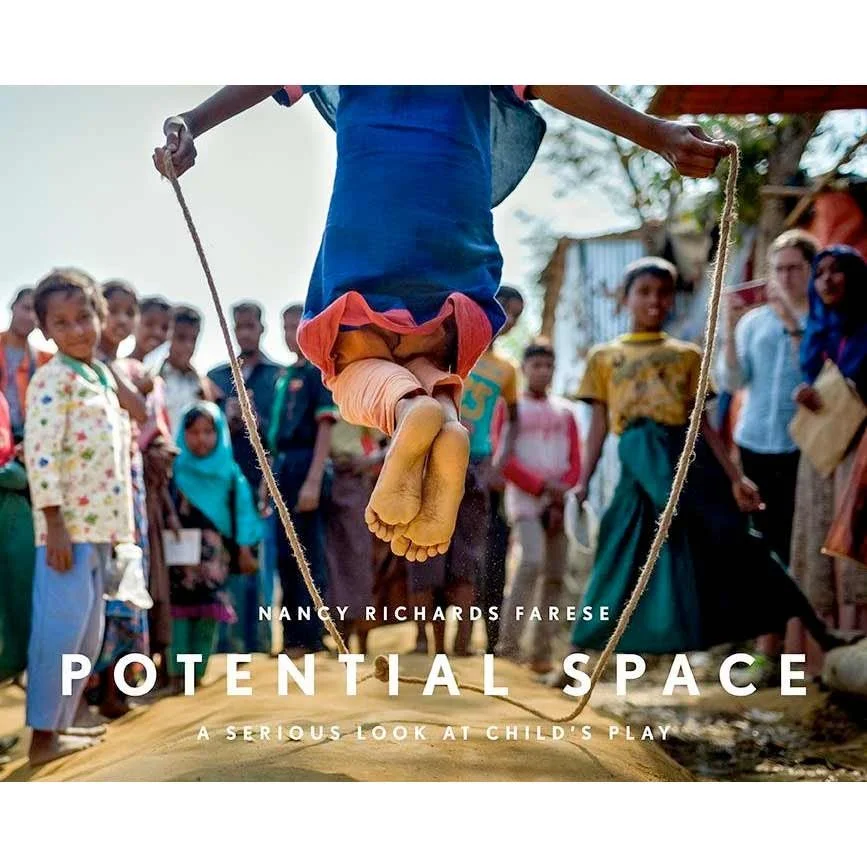Potential Space: A Serious Look at Child's Play
Potential Space: A Serious Look at Child's Play
Photographs by Nancy Richards Farese
Text by James Estrin
“In Potential Space, Farese implores us to protect the right of all children to dive into the primordial soup of free play, a key to a healthy life for us all.” – James Estrin, New York Times photographer and staff writer
In 2017, author and photographer Nancy Richards Farese visited Bangladesh to photograph the Rohingya refugee crisis, which forced over one million people into temporary camps as they fled the genocide in Myanmar. As she documented the toll of extreme trauma and the most violent tendencies of humankind, she was drawn to the irrepressible laughter of children as they fashioned sticks and rocks into toy cars and turned plastic bags into kites. Captivated by the joy, resilience, and creativity she witnessed, she turned her camera on children at play capturing their natural instincts to adapt, heal, and thrive despite the darker forces surrounding them.
Potential Space: A Serious Look at Child's Play (MW Editions, December 2021) brings together over ninety of Farese’s stunning, full-color images of children engaged in play—spontaneous, unselfconscious, free of adult supervision—that she took over seven years in fourteen countries, including Burkina Faso, Cuba, Haiti, Jordan, and the U.S.A. The book explores humanity’s relationship to play through the lens of diverse cultures, traditions, and economic situations around the world. Much of Farese’s work for the book was done on behalf of CARE International and the United Nations Commission on Refugees.
In her introduction, Farese writes, “Even as I carry my camera photographing the life of children at play everywhere, memories of my own play color and inform what I see in the field, contributing to the joy of the work. Though play can take seemingly infinite forms, we know it when we see it, anywhere in the world. Photography, therefore, is an ideal tool to capture the exuberance and complexity of what happens when we play. A game of jacks is recognizable whether it is played with stones in a dirt alley in Burkina Faso or with plastic pieces on a tiled floor in Bangkok. Dolls, kites, and balls appear everywhere in these photos, reminding us that many of these games, are our games too.”
Farese hopes her book will encourage people to re-think the modern-day approach to play which has become disorienting and extreme, to the point that it is hardly recognizable as a simple activity of happiness and wellbeing. The boundless, timeless “free play” that has developed and informed human beings since the dawn of time is now conflated with mass consumption and addictive technologies, to the point that “playing” video games, social media apps, or even a highly structured game of afterschool soccer leaves us feeling isolated, lethargic, and socially inadequate.
“We don’t stop playing because we grow old; we grow old because we stop playing,” playwright George Bernard Shaw once said. Play is a muscle of adaptation and resilience for our entire lives, a fundamental tool for survival, and an indicator of security and comfort for individuals and societies. Farese’s photos of children at play are both resonant and activating. They beg the question: Where does play sit in our own lives, and how do we ensure that children, everywhere, are allowed to play their way into a healthy adulthood, and a more just world?
Featuring a foreword by New York Times photographer and staff writer James Estrin, Potential Space offers a global view of a seemingly mundane activity that is a feature that defines both humanness and happiness. When we are at play, we lose ourselves in time, yet find ourselves most fully alive. Play can be both a window and a mirror, providing a path toward empathy and peace.
James Estrin writes, “In Potential Space: A Serious Look at Child’s Play, Nancy Richards Farese explores the universal and primal nature of child’s play through nuanced images that capture its unbridled joy and psychological complexity. Her photos not only make a compelling argument for the restorative nature of play, but also reveal the universal themes that tap into its existential importance.”
Book Specifications:
Clothbound
ISBN: 9781735762944
12 x 9.5 inches
144 pages
95 color illustrations
Author Bio:
Nancy Richards Farese is a photographer, author, and entrepreneur whose work promotes visual storytelling as an essential tool for social good. An award-winning documentary photographer, she has worked extensively for international development organizations including the United Nations High Commission on Refugees, CARE USA, RefugePoint, and the Carter Center. Farese holds a master’s degree in Public Administration from the Harvard Kennedy School and was a Fellow at the Shorenstein Center on Media, Politics, and Public Policy. Her writing has been published in the NiemanStoryboard, Atlanta Journal-Constitution, and San Francisco Chronicle. She is the founder of the visual storytelling nonprofits PhotoPhilanthropy (2009) and CatchLight (2015), and is a board member of Southwire Company, NPR Foundation, and CatchLight. Originally from Carrollton, Georgia, Farese now lives in Marin County, California.
Contributor Bio:
James Estrin is a senior staff writer and photographer at the New York Times, and the founder of its photojournalism blog, "Lens." Estrin was on the 2001 Pulitzer Prize-winning team that produced "How Race Is Lived in America," and is the co-executive producer of the documentary film "Underfire: The Untold Story of Pfc. Tony Vaccaro."

